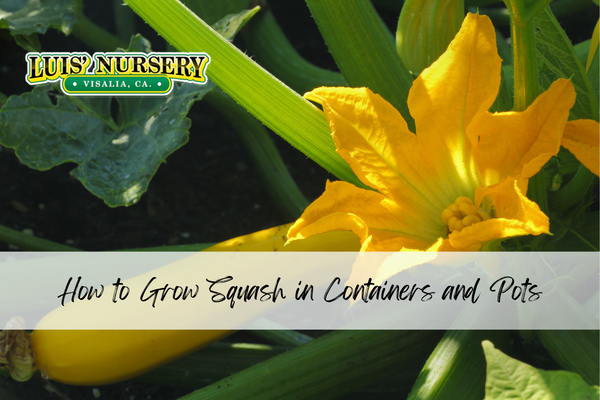Sometimes we have big garden dreams and limited garden real estate. Squash plants are prolific and come in all shapes, sizes and flavors. One way to grow squash when you have limited space is to grow them in containers and pots. When growing in containers and pots you can control the soil quality and keep ground pests off the plants. How do you successfully grow squash in containers?
The importance of light and temperature
One benefit of growing squash in containers is that you can place them in the spot in your garden where they will thrive. Your squash loves the sun. It’s important to place them in a sunny location that will receive a minimum of 6 to 8 hours of direct sunlight. They prefer temperatures in the mid-70’s or higher. The soil should be at least 60 degrees before seeds are sown in order to germinate.
How to start squash in pots
Squash can be grown in containers if they have their ideal growing needs met. It’s important that the container has proper drainage holes and is large enough that you can fill it with rich potting mix and water regularly. If you’d like to control the growth of your squash you can provide it with a trellis in order to grow it vertically, or they will likely overflow out of the container and spread.
It’s best to seed them directly in the container as they don’t prefer to be transplanted. They should be planted at least two weeks after the possibility of frost. You can start them indoors in order to get a head start if you’d like.
How to fertilize squash in pots
Squash draws their nutrients from the soil that they are planted in, so when growing them in containers you can amend the soil with worm castings, well-decomposed compost or a calcium and high phosphorous fertilizer that will protect against diseases like blossom rot.
How to water squash in pots
Squash needs 1 inch of water per week, especially during the budding and fruiting phase. Water can be retained by adding 2-3 inches of mulch around the established plants. It’s important to water the soil and not the plant to ward off fungal disease. When choosing your watering schedule try and water in the morning so the plant has plenty of time to hydrate before the sun is too hot and have its foliage dried by the sun.
How to ward of common squash plants pests and disease
Diseases and pests can be warded off by ensuring that your soil is rich in organic material, and they have good air circulation and proper watering. What are some common things to look for? Powdery Mildew can spread quickly on your plants and destroy your garden if not caught and fixed early. Proper spacing with sufficient airflow and early morning watering will help prevent this. Blossom rot occurs when your soil is lacking in calcium. It’s preventable by testing and amending your soil as needed. Squash Vine Borers and Cucumber Beetles like to burrow into vines and kill the plants. Keep an eye out for visible damage.
One last thing to note when growing squash in containers is that they will require pollination to produce. You’ll need to attract pollinators to your garden to encourage production. These few tips can help you to successfully grow squash in containers.

